Ceratopsid Dinosaurs are one of the most diverse and specious groups of herbivorous Ornithischian Dinosaurs, with a large number of species known from the Cretaceous of Asia and North America. The Earliest fossils appear in the Late Jurassic of China, with the earliest known species, Yinlong downsi, thought to have lived between 161.2 and 155.7 million years ago.
In a paper published in the journal PLoS One on 9 December 2015, Fenglu Han of the School of Earth Sciences at the China University of Geosciences and the Institute of Vertebrate Paleontology and Paleoanthropology of the Chinese Academy of Sciences, Catherine Forster and James Clark of the Department of Biological Sciences at The George Washington University and Xing Xu, also of the Institute of Vertebrate Paleontology and Paleoanthropology of the Chinese Academy of Sciences, describe a new species of Ceratopsid from the Late Jurassic Shishugou Formation of the Junggar Basin in Xinjiang Province, China; the same deposits that produced Yinlong downsi.
The new species is named Hualianceratops wucaiwanensis, where 'Hualianceratops' means 'Ornamental-faced Ceratopsid' and 'wucaiwanensis' means 'from Wucaiwan', the locality which produced both Hualianceratops wucaiwanensis and Yinlong downsi. The species is described from a single fragmentary skull and jaw and a few fragments of post-cranial skeleton. While these remains are somewhat limited, they can be distinguished from Yinlong downsi, indicating the presence of a second species of Ceratopsid living in the same area as Yinlong downsi, and at the same time. The two species are thought to be closely related.
The mandible of Hualianceratops wucaiwanensis. (A) photograph in lateral view, (B) drawing in lateral view, (C) photograph in ventral view, (D) drawing in ventral view. Abbreviations: an, angular; d, dentary; emf, external mandibular fenestra; imf, inner mandibular fenestra; lsp, left splenial; pra, prearticular; pd, predentary; rsp, right splenial; sa, surangular. Han et al. (2015).
See also...
 Regaliceratops peterhewsi: A new species of Chasmosaur from the Late Cretaceous of Alberta. Ceratopsids are among the most
distinctive and...
Regaliceratops peterhewsi: A new species of Chasmosaur from the Late Cretaceous of Alberta. Ceratopsids are among the most
distinctive and...
Ceratopsian
Dinosaurs are thought to have originated in Asia in the Early
Cretaceous, spreading to Europe and North America, and becoming the most
important and diverse group of herbivorous Dinosaurs in North America
by the end of the Period. Unfortunately...
Dinosaurs
underwent dramatic increases in size over a number of years during
their growth, and are presumed to have played a number of different
ecological...
Follow Sciency Thoughts on Facebook.



